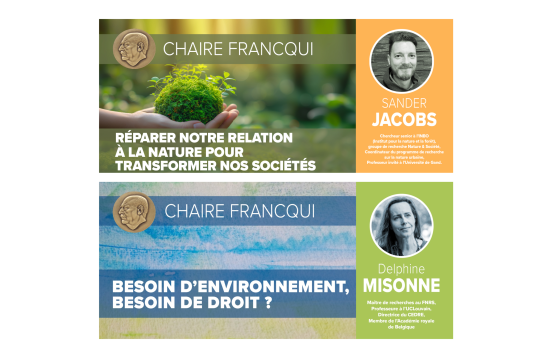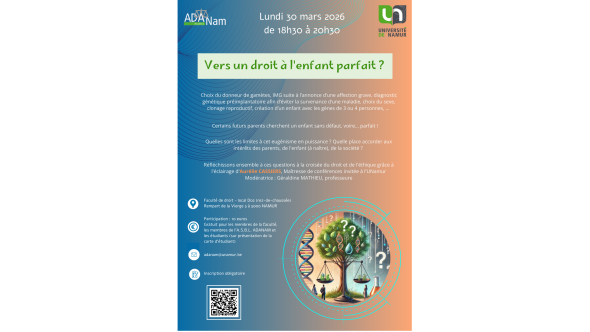The Faculty of Law is committed to helping students achieve excellence and autonomy. It conducts cutting-edge, interdisciplinary scientific research in key areas, notably through its research centers, CRIDS and Vulnérabilités et Sociétés. It organizes various services for society, such as continuing education for legal professionals.
Chaire Francqui 2025-2026 | Besoin d'environnement, besoin de droit ?
Leçon inaugurale | 27 novembre 2025 - Protéger l’environnement au-delà du politique
La Faculté de droit accueille la professeure Delphine Misonne à l’occasion d’une Chaire Francqui qui lui a été décernée par la Fondation Francqui : « Besoin d’environnement, besoin de droit ? ». L’organisation de cette chaire s’intègre pleinement dans le Fil Rouge de la Faculté de droit dédiée à ce substrat essentiel à la vie qu’est l’environnement, la nature, notre terre : « Réenchanter la terre »

The studies
The Faculty of Law offers a 3-year bachelor's degree course, either on a daytime or a staggered timetable. Bachelor's studies in law at the University of Namur offer a complete basic legal training, aimed at turning students into excellent general lawyers suitable for the Master's program in law.

Research
The Faculty of Law conducts cutting-edge, interdisciplinary scientific research. Rooted in today's society, it focuses its research priorities, in particular, around its two research centers: the CRIDS and the Centre Vulnérabilités et Sociétés. Doctoral training is offered to lawyers wishing to complete a doctoral thesis.

Service to society
As well as teaching and research, the University has a mission to serve society. As part of this, the Faculty of Law offers various continuing education activities for legal professionals. The Faculty's blog is also available, and shares Belgian and international legal news. Last but not least, the Faculty of Law Alumni Association is active: it's impossible to forget the Faculty after you've been there!

Organization
The Faculty is optimally organized to manage its missions of teaching, research and service to society.
The common thread in law
Since 2022, the Faculty of Law has chosen a theme for the year that unites the entire Faculty, students and teachers alike, across all blocks. This topic will be exploited in courses, framings, assignments, and during lectures and cultural activities offered throughout the academic year. A new dynamic that makes the University of Namur's framing even more unique.

The Faculty of Law in figures
Faculty Library
The Faculty of Law library holds around 20,000 books and subscribes to some 150 periodicals covering the various branches of law. It also houses the CRIDS (Centre de Recherche Information, Droit, Société) documentation center, as well as the Vulnérabilités et Sociétés documentation center.
Spotlight
News

Immersion in environmental advocacy for law students
Immersion in environmental advocacy for law students
On November 18, 2025, the Faculty of Law organized the fourth edition of its traditional criminal law mock trial. Seven students, from the daytime and staggered schedules, donned their gowns to embody the various players in a trial devoted to a case of illegal rave party in the middle of a protected natural area. Pleadings and indictments were the order of the day. It was also an opportunity to recall how environmental criminal law protects nature, and to discover criminal justice a little more closely.

This year, the trial concerned a case dating back to July 2025: an illegal rave party, gathering some 1,200 people having been held at Ohey, near Namur, in the middle of a protected natural area. "This case is linked to this year's Fil Rouge, "Réenchantons la Terre".It involves a case that caused significant damage to nature, but also acts of violence, with and without a discriminatory motive, between a participant and a local resident", explains Emma Bourcelet, assistant at the Faculty of Law and co-organizer of the event. "In particular, the idea was to show how environmental criminal law can be a tool for defending nature."
Seven students carefully prepared their speeches, each in a different role: Théophile Renier, Aurélie Lemmens, Albiona Sefedini, Louis Jaspard, Dorien Huys, Nateo Carnot and Laly Vadevorst. The staff surrounding the project included: Nathalie Colette-Bazecq, Dean of the Faculty of Law, Amani Pici, PhD student, Amélie Lachapelle, UNamur doctorate in legal sciences, ELSA Namur (European Law Students' Association) and Emma Bourcelet.
Distinguished guests
Special guests
The Faculty of Law welcomed two guests: Julien Moinil, King's Public Prosecutor in Brussels and didactic collaborator in criminal law, who presided over the court during the mock trial, and Sarah Coisne, judge at the Liège Court of Appeal, who had provided the real case file that served as the basis for the facts submitted to the students.
"Julien Moinil's experience as a practitioner and alumnus of the Faculty was a real source of inspiration," Emma Bourcelet points out. "As for Sarah Coisne, she not only contributed to the deliberations for the verdict, but also shared her experience and the diversity of cases in environmental criminal law. The audience was thus able to appreciate the beauty and role of the law in shaping our world in the service of protecting living things. "
Between surpassing oneself and emotions
The pedagogical benefits of such an exercise for students are numerous! "First and foremost, it's a real collective intelligence process where personalities combine to give a unique color to the project. The rigor imposed pushes participants to develop a legal analysis applied to real facts, which enables them to go beyond pure theory. Building a coherent, relevant argument is an invaluable exercise for their future careers, whatever they may be. Finally, learning to speak, role-play and overcome certain fears is a major challenge. Seeing their evolution in just one month is impressive," enthuses Emma Bourcelet.
On this November 18, the emotion was palpable in UNamur's Pedro Arrupe auditorium. "These students are in their second year, they don't yet have all the criminal law material, they find out about the case a month before the event... and yet, the magic happens!" confides Emma Bourcelet.

Special mention to Dorien, a Dutch-speaking student, who took up the challenge in French. Seeing them surpass themselves, the collective spirit, and even the presence of former participants in the audience... it's also a sign that this experience leaves a positive mark, and it's one of the most beautiful gifts of our professions.

Two complementary points of view to put environmental protection back at the heart of public debate
Two complementary points of view to put environmental protection back at the heart of public debate
The University of Namur is soon to offer two inaugural lessons for two Francqui Chairs, one in the Faculty of Science and the other in the Faculty of Law. Open to all, the inaugural lectures will be followed by a local drink. These events are free, upon registration.

Chaire Francqui 2025-2026 en sciences | Repairing our relationship with Nature to transform our societies
The biodiversity crisis isn't just destroying nature: it's also threatening our societies, our well-being and our survival. Based on the scientific assessments and findings of the IPBES (Intergovernmental Science-Policy Platform on Biodiversity and Ecosystem Services), this Francqui Chair will explore our toxic relationship with nature, the global failure to protect it, and the multiple values of living things.
Speaker: Sander Jacobs, Senior Researcher at INBO (Institute for Nature and Forestry), Nature & Society research group, Coordinator of the Urban Nature research program and Visiting Professor at Ghent University.
19/11/2025 - Inaugural lecture | Biodiversity crisis: causes, consequences, and how (not) to get out of it.
Francqui 2025-2026 Chair in Law | Need for environment, need for law?
This Francqui Chair offers a fresh look at the advances but also the tensions that today characterize the way the law organizes society's relationship with the environment. If the ambition to protect the environment has indeed become a legal issue, how are its essential mainsprings evolving, whether in climate matters, in the relationship to human health, or in the status accorded to nature?
The organization of this Chair is fully integrated into the Law School's Fil Rouge 2025-2026 dedicated to this substratum essential to life that is the environment, nature, our earth: "Réenchanter la terre".
Orator: Delphine Misonne, Senior Research Fellow FNRS, Professor at UCLouvain, Director of CEDRE and member of the Royal Academy of Belgium.
27/11/2025 - Inaugural Lesson I Protecting the environment beyond politics

Digital literacy through fiction: NaDI's interdisciplinary initiative
Digital literacy through fiction: NaDI's interdisciplinary initiative
The Namur Digital Institute (NaDI) is launching a series of original events: "Les Séances du Numérique". Films followed by debates with experts to understand digital challenges and stimulate collective thinking. A project spearheaded by Anthony Simonofski, Anne-Sophie Collard, Benoît Vanderose and Fanny Barnabé.

The Digital Sessions are an initiative launched by the NaDI, the digital research institute at UNamur. The latter brings together researchers from the Faculties of law, informatics and EMCP.
To stimulate interdisciplinary collaboration, NaDI has launched a call for projects. One of the selected projects? Les Séances du Numérique, an original format in which fiction becomes the starting point for debate. Each meeting begins with a film screening, followed by an interdisciplinary conference on a digital-related social issue.
An outstanding first Séance du Numérique
To inaugurate the cycle, the team chose to screen The Social Network last May. The film traces the creation of Facebook by Mark Zuckerberg, and the debate focused on the moderation of social networks, a hot topic since the election of Donald Trump. Two experts led the discussion: Julien Albert, expert at the PReCISE center, and Jérémy Grossman, expert at CRIDS.

Educating through fiction
The ambition of these sessions is simple: to educate about digital issues through fiction, and to confront a variety of viewpoints.
This format extends the experience of the podcast Pop-Code already hosted by Anthony Simonofski and Benoît Vanderose, but with an added dimension: interdisciplinarity and direct exchange with the audience. After the film, everyone can question the experts and enrich the reflection.
What next?
Digital technology will be at the heart of future screenings, with a dynamic that is both collaborative and rooted in current affairs:
- Fostering collaboration between several NaDI centers to bring disciplines into dialogue (as was the case at the first session with CRIDS and PReCISE).
- Bouncing off themes linked to current events to guarantee the relevance of exchanges.
Four sessions will be offered per year, open to all, with one priority: reaching out to citizens. The films are there to give the event a cultural and scientific outreach.
Eventually, the team would like to diversify its formats: screenings in cinemas like Caméo, broadcasting series, even playconferences where we play a video game during the debate. The idea: to use fiction in all its forms to kick-start discussion.
The team behind the project
- Fanny Barnabé, lecturer at CRIDS / NaDI
- Anne-Sophie Collard, professor at the EMCP Faculty
- Anthony Simonofski, professor at the EMCP Faculty
- Benoît Vanderose, professor at the Computer Science Faculty
In collaboration with the Knowledge Confluence and the Administration de la communication
Next session: November 4 - "Does AI have a conscience?"
Projection of the film Ex Machina followed by a discussion with Isabelle Linden and Benoît Frenay.
Think, think: is the human being still unique?
Behind the AI revolution, a question arises: does AI have a conscience? For this second screening-debate of Séances du Numérique, we invite you to dive into the film Ex_machina, a troubling face-off between creation and creator, between human and machine, between future and humanity.
Program:
- 5pm: Welcome & film presentation
- 5:15pm: Screening of the film Ex machina
- 7:05pm: Debate "Does AI have a conscience? " (with Isabelle Linden & Benoît Frenay)
- 19h45: end
Two experts will take part in the debate:
- Benoît Frenay, who will shed light on the learning logics of today's artificial intelligences and the limits of their "autonomy". Can we really speak of intelligence without consciousness? How far can imitation go?
- Isabelle Linden, who will question the very foundations of what we call "thinking" in a computer logic. Can we create a conscious machine? Or are we merely facing mirrors of our own desires?


Artificial intelligence, a danger for democracy?
Artificial intelligence, a danger for democracy?
Can we still speak of democracy when algorithms influence our electoral choices or participate in the drafting of laws? This topic is explored by Aline Nardi, researcher at the Faculty of Law and member of the Namur Digital Institute (NADI).

Several projects are already aiming to entrust part of the legislative work to artificial intelligence (AI). While for the time being, these are mainly tools for transcribing parliamentary debates, translating or analyzing archives, drafting tools or legislative texts are also being considered. The use of AI may seem interesting: it can improve readability or facilitate standardization. But, depending on how it is used, it may not spontaneously respect the fundamental principles of the legislative process, such as legality, proportionality or equality. These requirements, established by the Constitutional Court, are the subject of numerous case law decisions. As part of a doctoral thesis, Aline Nardi, is sifting through them to see whether the use of AI is possible in legislative processes.
His finding? "For csome more critical tasks, which go beyond simple editing, problems arise." In particular, she points to the opacity of the reasoning, since "it is difficult to trace why the AI suggests such and such a lead from the query submitted to it". Yet, in a state governed by the rule of law, the legislative process must be transparent and comprehensible if it is to be challenged by parliamentarians and citizens.
There are also issues of democratic legitimacy: "The company that develops the system used by parliamentary assemblies can influence decisions that are extremely important for a nation. Is a parliamentarian still useful if he or she is only there to ratify decisions made by a machine?" asks the jurist.
Elections influenced by AI
On the citizens' side, AI has been transforming election campaigns for some years now. Micro-targeting, automated disinformation, manipulation of emotions via social networks: these are all formidable tools that can skew public debate. The 2016 US presidential campaign clearly illustrates this problem."Cambridge Analytica, for example, targeted and influenced undecided voters whose positions could be tilted in Donald Trump's favor. Around 20 million undecided voters thus received tailored messages, such as memes, videos, blog posts in favor of Trump", recalls Aline Nardi. Combined with social networks, AI therefore calls into question the right of voters to form an opinion based on pluralist and reliable information.
More recently, the Romanian Constitutional Court invalidated the 2024 presidential election on the grounds of misuse of AI and lack of transparency in digital campaigns. "This affected the freely expressed nature of the citizens' vote and in particular their right to be properly informed, explains Aline Nardi.
The European Union is trying to take action against these abuses. Several regulations have been put in place. They aim to frame digital technologies and limit their harmful effects on the information space, particularly during electoral processes. These regulations include the Digital Services Act (DSA), the AI Regulation and the Transparency and Targeting of Political Advertising Regulation (TTPA). These regulations have prompted Google, and more recently Meta, to stop allowing political, electoral and social issue advertising in the European Union.
"However, questions remain as to the applicability, concrete implementation and effectiveness of certain standards stemming from bodies of digital law", alerts Aline Nardi, who calls for "sortir de ce flou juridique".
On the same subject
- University and democracy: a living link, sometimes threatened
An academic year dedicated to democracy
Find the speech given by Rectrice Annick Castiaux at the 2025-2026 Academic Back-to-School Ceremony.

Cet article est tiré de la rubrique "Le jour où" du magazine Omalius #38 (Septembre 2025).


Immersion in environmental advocacy for law students
Immersion in environmental advocacy for law students
On November 18, 2025, the Faculty of Law organized the fourth edition of its traditional criminal law mock trial. Seven students, from the daytime and staggered schedules, donned their gowns to embody the various players in a trial devoted to a case of illegal rave party in the middle of a protected natural area. Pleadings and indictments were the order of the day. It was also an opportunity to recall how environmental criminal law protects nature, and to discover criminal justice a little more closely.

This year, the trial concerned a case dating back to July 2025: an illegal rave party, gathering some 1,200 people having been held at Ohey, near Namur, in the middle of a protected natural area. "This case is linked to this year's Fil Rouge, "Réenchantons la Terre".It involves a case that caused significant damage to nature, but also acts of violence, with and without a discriminatory motive, between a participant and a local resident", explains Emma Bourcelet, assistant at the Faculty of Law and co-organizer of the event. "In particular, the idea was to show how environmental criminal law can be a tool for defending nature."
Seven students carefully prepared their speeches, each in a different role: Théophile Renier, Aurélie Lemmens, Albiona Sefedini, Louis Jaspard, Dorien Huys, Nateo Carnot and Laly Vadevorst. The staff surrounding the project included: Nathalie Colette-Bazecq, Dean of the Faculty of Law, Amani Pici, PhD student, Amélie Lachapelle, UNamur doctorate in legal sciences, ELSA Namur (European Law Students' Association) and Emma Bourcelet.
Distinguished guests
Special guests
The Faculty of Law welcomed two guests: Julien Moinil, King's Public Prosecutor in Brussels and didactic collaborator in criminal law, who presided over the court during the mock trial, and Sarah Coisne, judge at the Liège Court of Appeal, who had provided the real case file that served as the basis for the facts submitted to the students.
"Julien Moinil's experience as a practitioner and alumnus of the Faculty was a real source of inspiration," Emma Bourcelet points out. "As for Sarah Coisne, she not only contributed to the deliberations for the verdict, but also shared her experience and the diversity of cases in environmental criminal law. The audience was thus able to appreciate the beauty and role of the law in shaping our world in the service of protecting living things. "
Between surpassing oneself and emotions
The pedagogical benefits of such an exercise for students are numerous! "First and foremost, it's a real collective intelligence process where personalities combine to give a unique color to the project. The rigor imposed pushes participants to develop a legal analysis applied to real facts, which enables them to go beyond pure theory. Building a coherent, relevant argument is an invaluable exercise for their future careers, whatever they may be. Finally, learning to speak, role-play and overcome certain fears is a major challenge. Seeing their evolution in just one month is impressive," enthuses Emma Bourcelet.
On this November 18, the emotion was palpable in UNamur's Pedro Arrupe auditorium. "These students are in their second year, they don't yet have all the criminal law material, they find out about the case a month before the event... and yet, the magic happens!" confides Emma Bourcelet.

Special mention to Dorien, a Dutch-speaking student, who took up the challenge in French. Seeing them surpass themselves, the collective spirit, and even the presence of former participants in the audience... it's also a sign that this experience leaves a positive mark, and it's one of the most beautiful gifts of our professions.

Two complementary points of view to put environmental protection back at the heart of public debate
Two complementary points of view to put environmental protection back at the heart of public debate
The University of Namur is soon to offer two inaugural lessons for two Francqui Chairs, one in the Faculty of Science and the other in the Faculty of Law. Open to all, the inaugural lectures will be followed by a local drink. These events are free, upon registration.

Chaire Francqui 2025-2026 en sciences | Repairing our relationship with Nature to transform our societies
The biodiversity crisis isn't just destroying nature: it's also threatening our societies, our well-being and our survival. Based on the scientific assessments and findings of the IPBES (Intergovernmental Science-Policy Platform on Biodiversity and Ecosystem Services), this Francqui Chair will explore our toxic relationship with nature, the global failure to protect it, and the multiple values of living things.
Speaker: Sander Jacobs, Senior Researcher at INBO (Institute for Nature and Forestry), Nature & Society research group, Coordinator of the Urban Nature research program and Visiting Professor at Ghent University.
19/11/2025 - Inaugural lecture | Biodiversity crisis: causes, consequences, and how (not) to get out of it.
Francqui 2025-2026 Chair in Law | Need for environment, need for law?
This Francqui Chair offers a fresh look at the advances but also the tensions that today characterize the way the law organizes society's relationship with the environment. If the ambition to protect the environment has indeed become a legal issue, how are its essential mainsprings evolving, whether in climate matters, in the relationship to human health, or in the status accorded to nature?
The organization of this Chair is fully integrated into the Law School's Fil Rouge 2025-2026 dedicated to this substratum essential to life that is the environment, nature, our earth: "Réenchanter la terre".
Orator: Delphine Misonne, Senior Research Fellow FNRS, Professor at UCLouvain, Director of CEDRE and member of the Royal Academy of Belgium.
27/11/2025 - Inaugural Lesson I Protecting the environment beyond politics

Digital literacy through fiction: NaDI's interdisciplinary initiative
Digital literacy through fiction: NaDI's interdisciplinary initiative
The Namur Digital Institute (NaDI) is launching a series of original events: "Les Séances du Numérique". Films followed by debates with experts to understand digital challenges and stimulate collective thinking. A project spearheaded by Anthony Simonofski, Anne-Sophie Collard, Benoît Vanderose and Fanny Barnabé.

The Digital Sessions are an initiative launched by the NaDI, the digital research institute at UNamur. The latter brings together researchers from the Faculties of law, informatics and EMCP.
To stimulate interdisciplinary collaboration, NaDI has launched a call for projects. One of the selected projects? Les Séances du Numérique, an original format in which fiction becomes the starting point for debate. Each meeting begins with a film screening, followed by an interdisciplinary conference on a digital-related social issue.
An outstanding first Séance du Numérique
To inaugurate the cycle, the team chose to screen The Social Network last May. The film traces the creation of Facebook by Mark Zuckerberg, and the debate focused on the moderation of social networks, a hot topic since the election of Donald Trump. Two experts led the discussion: Julien Albert, expert at the PReCISE center, and Jérémy Grossman, expert at CRIDS.

Educating through fiction
The ambition of these sessions is simple: to educate about digital issues through fiction, and to confront a variety of viewpoints.
This format extends the experience of the podcast Pop-Code already hosted by Anthony Simonofski and Benoît Vanderose, but with an added dimension: interdisciplinarity and direct exchange with the audience. After the film, everyone can question the experts and enrich the reflection.
What next?
Digital technology will be at the heart of future screenings, with a dynamic that is both collaborative and rooted in current affairs:
- Fostering collaboration between several NaDI centers to bring disciplines into dialogue (as was the case at the first session with CRIDS and PReCISE).
- Bouncing off themes linked to current events to guarantee the relevance of exchanges.
Four sessions will be offered per year, open to all, with one priority: reaching out to citizens. The films are there to give the event a cultural and scientific outreach.
Eventually, the team would like to diversify its formats: screenings in cinemas like Caméo, broadcasting series, even playconferences where we play a video game during the debate. The idea: to use fiction in all its forms to kick-start discussion.
The team behind the project
- Fanny Barnabé, lecturer at CRIDS / NaDI
- Anne-Sophie Collard, professor at the EMCP Faculty
- Anthony Simonofski, professor at the EMCP Faculty
- Benoît Vanderose, professor at the Computer Science Faculty
In collaboration with the Knowledge Confluence and the Administration de la communication
Next session: November 4 - "Does AI have a conscience?"
Projection of the film Ex Machina followed by a discussion with Isabelle Linden and Benoît Frenay.
Think, think: is the human being still unique?
Behind the AI revolution, a question arises: does AI have a conscience? For this second screening-debate of Séances du Numérique, we invite you to dive into the film Ex_machina, a troubling face-off between creation and creator, between human and machine, between future and humanity.
Program:
- 5pm: Welcome & film presentation
- 5:15pm: Screening of the film Ex machina
- 7:05pm: Debate "Does AI have a conscience? " (with Isabelle Linden & Benoît Frenay)
- 19h45: end
Two experts will take part in the debate:
- Benoît Frenay, who will shed light on the learning logics of today's artificial intelligences and the limits of their "autonomy". Can we really speak of intelligence without consciousness? How far can imitation go?
- Isabelle Linden, who will question the very foundations of what we call "thinking" in a computer logic. Can we create a conscious machine? Or are we merely facing mirrors of our own desires?


Artificial intelligence, a danger for democracy?
Artificial intelligence, a danger for democracy?
Can we still speak of democracy when algorithms influence our electoral choices or participate in the drafting of laws? This topic is explored by Aline Nardi, researcher at the Faculty of Law and member of the Namur Digital Institute (NADI).

Several projects are already aiming to entrust part of the legislative work to artificial intelligence (AI). While for the time being, these are mainly tools for transcribing parliamentary debates, translating or analyzing archives, drafting tools or legislative texts are also being considered. The use of AI may seem interesting: it can improve readability or facilitate standardization. But, depending on how it is used, it may not spontaneously respect the fundamental principles of the legislative process, such as legality, proportionality or equality. These requirements, established by the Constitutional Court, are the subject of numerous case law decisions. As part of a doctoral thesis, Aline Nardi, is sifting through them to see whether the use of AI is possible in legislative processes.
His finding? "For csome more critical tasks, which go beyond simple editing, problems arise." In particular, she points to the opacity of the reasoning, since "it is difficult to trace why the AI suggests such and such a lead from the query submitted to it". Yet, in a state governed by the rule of law, the legislative process must be transparent and comprehensible if it is to be challenged by parliamentarians and citizens.
There are also issues of democratic legitimacy: "The company that develops the system used by parliamentary assemblies can influence decisions that are extremely important for a nation. Is a parliamentarian still useful if he or she is only there to ratify decisions made by a machine?" asks the jurist.
Elections influenced by AI
On the citizens' side, AI has been transforming election campaigns for some years now. Micro-targeting, automated disinformation, manipulation of emotions via social networks: these are all formidable tools that can skew public debate. The 2016 US presidential campaign clearly illustrates this problem."Cambridge Analytica, for example, targeted and influenced undecided voters whose positions could be tilted in Donald Trump's favor. Around 20 million undecided voters thus received tailored messages, such as memes, videos, blog posts in favor of Trump", recalls Aline Nardi. Combined with social networks, AI therefore calls into question the right of voters to form an opinion based on pluralist and reliable information.
More recently, the Romanian Constitutional Court invalidated the 2024 presidential election on the grounds of misuse of AI and lack of transparency in digital campaigns. "This affected the freely expressed nature of the citizens' vote and in particular their right to be properly informed, explains Aline Nardi.
The European Union is trying to take action against these abuses. Several regulations have been put in place. They aim to frame digital technologies and limit their harmful effects on the information space, particularly during electoral processes. These regulations include the Digital Services Act (DSA), the AI Regulation and the Transparency and Targeting of Political Advertising Regulation (TTPA). These regulations have prompted Google, and more recently Meta, to stop allowing political, electoral and social issue advertising in the European Union.
"However, questions remain as to the applicability, concrete implementation and effectiveness of certain standards stemming from bodies of digital law", alerts Aline Nardi, who calls for "sortir de ce flou juridique".
On the same subject
- University and democracy: a living link, sometimes threatened
An academic year dedicated to democracy
Find the speech given by Rectrice Annick Castiaux at the 2025-2026 Academic Back-to-School Ceremony.

Cet article est tiré de la rubrique "Le jour où" du magazine Omalius #38 (Septembre 2025).

Agenda
Conference - Towards a right to the perfect child?
Choice of gamete donor, IMG following the announcement of a serious condition, preimplantation genetic diagnosis to prevent the occurrence of a disease, choice of sex, reproductive cloning, creation of a child with the genes of 3 or 4 people... Some prospective parents are looking for a child without defects, or even... a perfect child! What are the limits to this potential eugenics? How much weight should be given to the interests of the parents, the (unborn) child, and society?

Let's reflect together on these questions at the intersection of law and ethics, with insights from Aurélie Cassiers, visiting lecturer at UNamur.
Moderator: Géraldine Mathieu, professor at UNamur.








